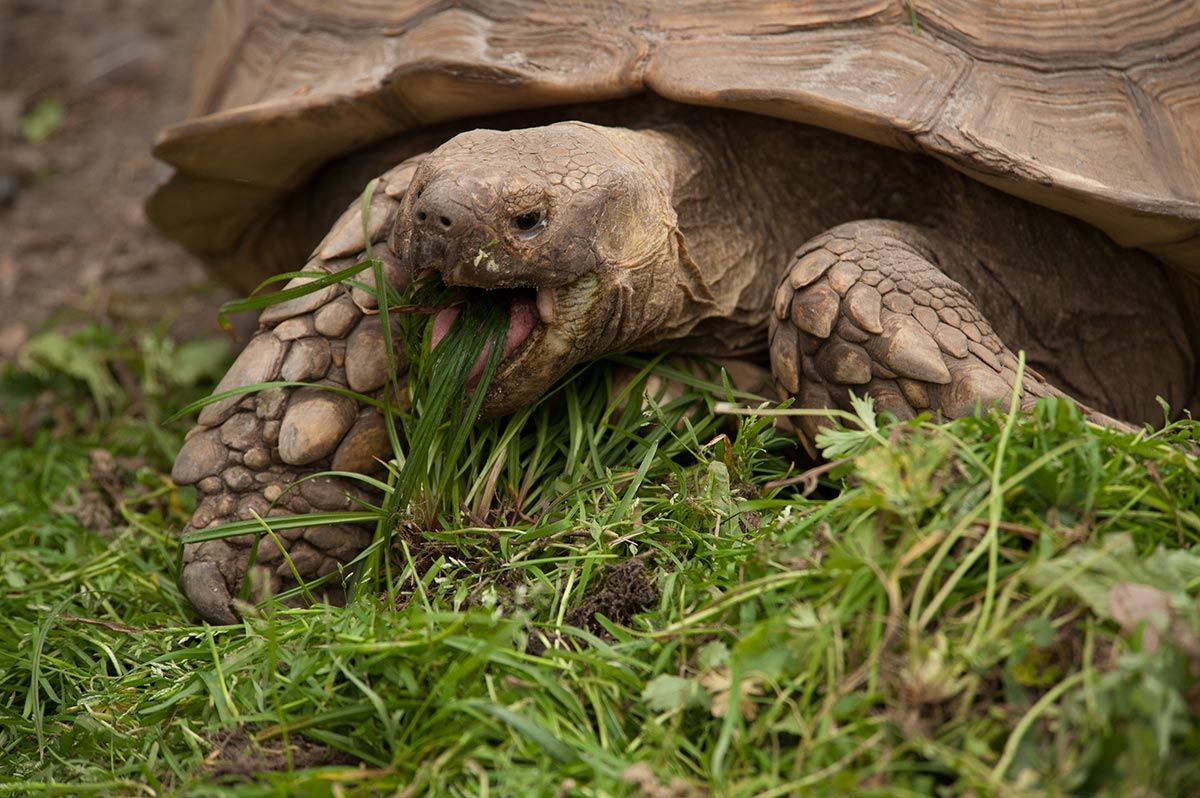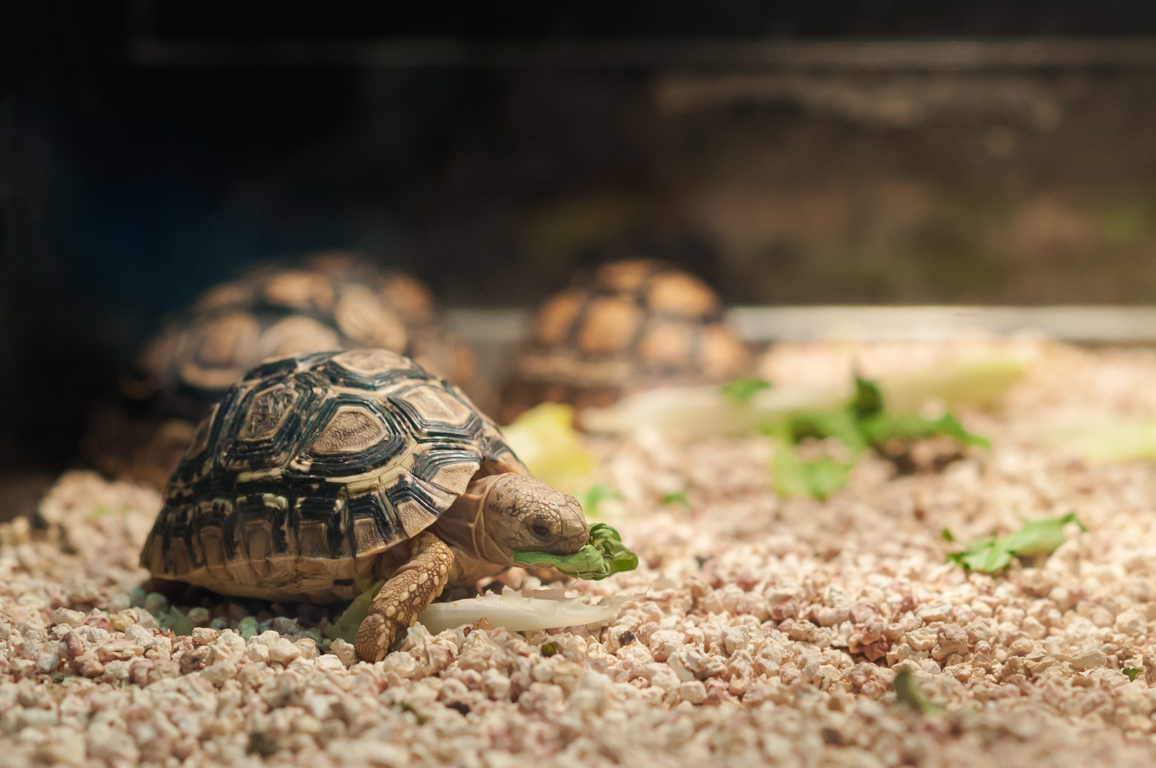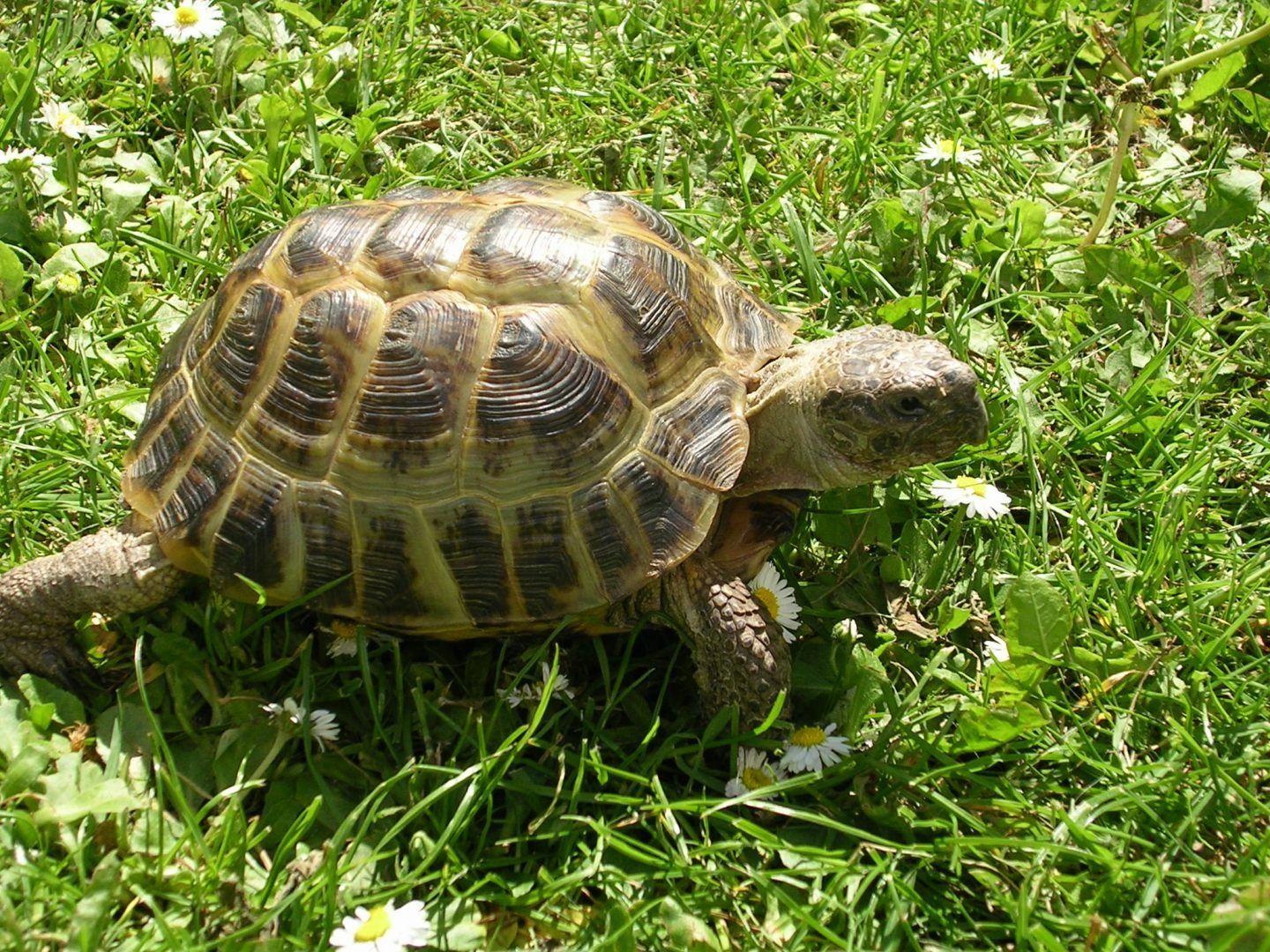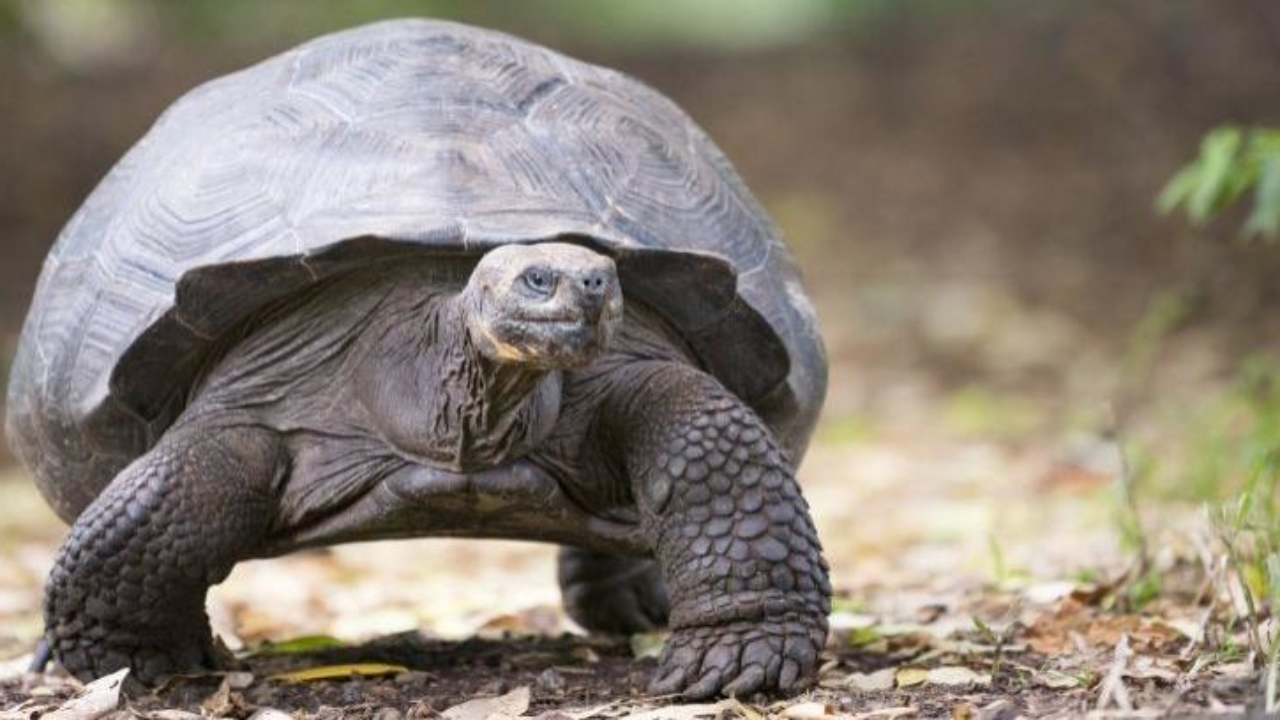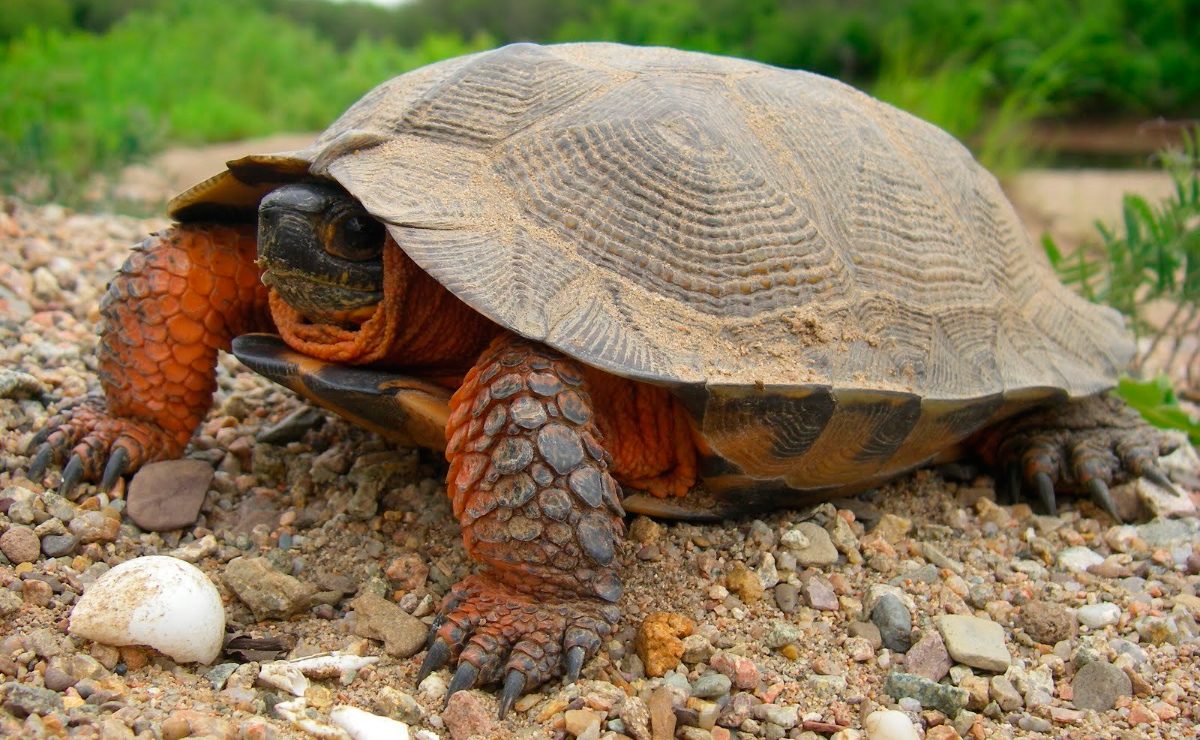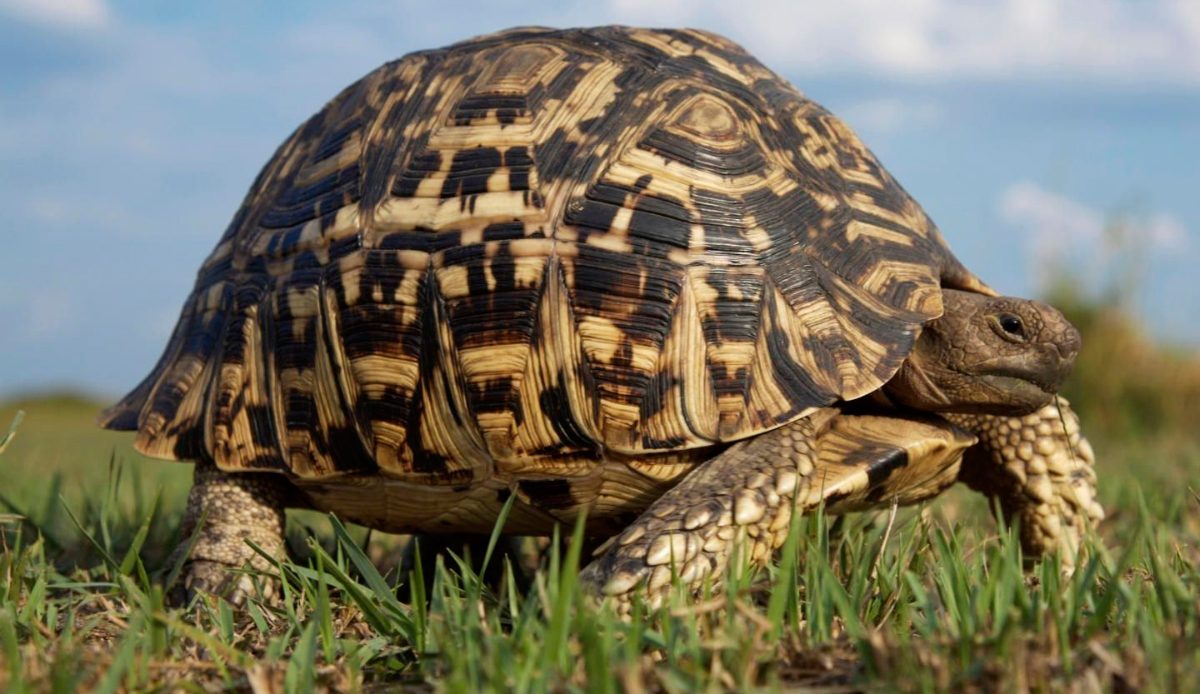Turtles, chelonians or even also known within the scientific community as Testudines, are animals that are members of an order of reptiles called Sauropsida, and they are also the oldest group of reptiles that exists today, since they have their origin in the Triassic period. If you want to learn much more about all the types of tortoises that exist, do not hesitate for a moment to leave without first having read this great article.

Turtles
The most characteristic physical feature of these beautiful reptiles is their enormous shell, which covers their entire wide and short torso, not to mention that it also protects all their internal organs. Next in this article we will review all the types of tortoises that exist and also the unique characteristics of each of these.
Features
As mentioned above, turtles are reptiles that have a fairly large shell that is made up of different very compact plates which are joined by a plastron, in turn, this same shell serves mainly to protect its organs and skeleton. Also, despite the fact that it seems that their shell is separated from the body of the turtles, the reality is that their ribs are attached to it, therefore it is impossible for them to separate from it.
The turtles have a very strong and pointed mouth, although they totally lack teeth. They have a fairly long and flexible neck that helps them to stretch their head a lot, although they also use it mainly to hide their head in the shell at a very high speed, this they do only when they feel threatened or in situations of great stress.
This type of turtle is cold blooded. They have two pairs of legs and also a tail whose size and shape can vary completely depending on the species and its sex. In turn, it is very important to mention that land turtles have a size that ranges approximately between 26 and 30 centimeters in total length; Like many species of animals, in the case of tortoises there is sexual dimorphism, that is, the females are slightly larger than the males.
What are land turtles like?
First of all, as mentioned in this article, tortoises are reptiles; They have a total length that can normally range between 25 and 30 centimeters, although the smallest species can measure only 12 centimeters, in addition to this, they can weigh between 600 grams and 1 kilogram.
The life expectancy of these beautiful reptiles usually ranges between 10 and 90 years, although many of these turtles can easily live up to 100 years of age. In addition to this, they reach their sexual maturity between approximately seven and nine years old, and once there, they can begin to reproduce in an ovoviviparous way, it should be noted that in each clutch they can lay between five or seven eggs, which they will have an incubation that will last between two and three months.
Tortoises are also animals that have diurnal habits and are quite passive and calm, although in very few cases they can become somewhat aggressive. Its diet is completely herbivorous. Despite the aforementioned, the average lifespan of land turtles is at least 60 years, which becomes a very important factor, because if you intend to adopt one of these reptiles, he will spend almost all your life life by your side
Types of Land Turtles
Land turtles have a fairly long and flexible neck with which they can stretch their head a lot to reach different foods, and they can also hide it quite quickly to protect themselves from different dangers, such as their predators or the same human beings.
Although turtles are completely toothless, their mouths have a beak-like definition and they also have quite strong jaws. Unlike sea turtles, tortoises do not have membranes on their feet and their toes are much more developed for walking on land.
These unique reptiles can also regulate their body temperature based on the temperatures of their entire environment; It is for this reason that the vast majority of these turtles usually hibernate during the winters. However, in the case of domestic tortoises, this hibernation is completely absent, or it may occur to a lesser degree because the temperatures in our home will always be much more stable. Below you can find a list of the types of tortoises that exist:
box turtle
The box turtle is a reptile that can be found mainly in Mexico and the United States of America. The shell of these turtles has a dome shape with an articulated lower part, which allows them to close their shell whenever they want to protect themselves from any type of threat. Normally, this same shell is usually brown with some orange or slightly yellowish drawings. The ventral part or also called plastron is very dark brown and is usually a uniform color, although it can also have some dark spots.
This class of turtles usually have a fairly small head and their mouth is in the shape of a hook. In the case of the male turtles of this species, they have a fairly reddish iris, while on the other hand, the females have a yellowish iris. In addition to this, males tend to have slightly shorter and more robust nails on their front legs, and their tail is also slightly longer and wider. This specific species of turtle can have a size that ranges between 15 and 20 centimeters in total length.
mediterranean tortoise
Mediterranean tortoises, basically, are a species of tortoises that can only live in regions of the world with Mediterranean climates. Its shell is convex, slightly less than that of the aforementioned species, with some very dark and brown tones or spots. The ventral area of its shell is much lighter in color, and has two somewhat darker spots that cover it almost completely.
As occurs in many species of tortoises, in Mediterranean tortoises there is a sexual dimorphism, that is, the males of this species are considerably smaller than the females, their tail is larger and longer and the ventral region it is concave, on the contrary, in the case of females it is completely flat. The drawing of the shell and its size will depend entirely on the area where this turtle in question comes from, however, the most normal thing is that its size ranges between 18 and 21 centimeters in total length.
russian tortoise
Russian tortoises are the most common land tortoise species to adopt as a pet. The shell of these reptiles is quite flattened, it is much less convex compared to all other species of tortoises and also has a slightly rounded shape. The color of this same shell has brownish tones with some yellow and ocher touches.
All its legs are quite robust and have four quite defined and long nails. The shields that it has on the ventral region of its body are quite dark but have clear edges. Like the species mentioned above, Russian tortoises have sexual dimorphism, since females usually have a size that ranges between 20 and 22 centimeters in total length, while on the other hand, males have between 16 and 18 centimeters in length. It is noteworthy that the tail of these turtles ends in a horny spike.
black tortoise
The spur-thighed tortoises are reptiles that can be found in Asia, Europe and also in Africa. These have a more convex shell with yellowish and olive green tones, in addition, each of the plates of its shell has a dark edge. In its ventral region it has a yellow color with some black spots. It is worth mentioning that one of the main characteristics of this species is that it has the plate that is above the undivided tail.
The head of this species of turtle has a yellowish color with very large dark spots, not counting the two prominent scales that it also has on its head. In turn, the spur-thighed tortoises have quite bulging eyes just like frogs can have; around all their legs they have very large and pointed scales, I also feel their hind legs a little smaller than the front ones. On their hind legs they have four fairly long and sharp nails and on their front legs they have five of these.
Its tail is much shorter than that of other species of land turtles, and unlike what happens with the Russian tortoise, the spur-thighed tortoise does not have a spur on its tail, however, they do have one on each of their thighs. The size of this species can vary greatly depending on the subspecies of the turtle; for example, in the spur-thighed tortoises of the Iberian Peninsula, they can measure on average between 15 and 18 centimeters in total length; and like all tortoises, the females are also considerably larger than the males.
Buy a Land Turtle
Tortoises are a kind of animal that can become domestic, however, they require quite rigorous care that is not respected in all situations. Before adopting one of these beautiful reptiles, you must be very careful and completely determined that you are going to take care of it for almost its entire life, well, remember that turtles are extremely long-lived animals that have a life expectancy almost equal to the of human beings; specifically, semi-aquatic turtles usually live between 10 and 20 years and in the case of terrestrial turtles, they can easily live between 80 and 100 years of age.
You must be very aware of all the enormous responsibility that adopting one of these reptiles as a pet entails and you must inform yourself quite well about each and every one of the care that they need to lead a very long and happy life. Below you can clearly see all the care that a turtle needs and where to adopt one of these.
Where to buy
In the event that you want to adopt a tortoise, first of all you must completely adapt your house so that your new pet can live without any difficulty. Now, when buying them, it is best to go with a good reputable seller and with all his licenses; this same seller must have the turtles in adequate facilities so that they live in good conditions and keep them in a healthy state and appearance. In addition to all this, you must also have all the documentation and information that is required about each and every one of the turtles that you have.
The most normal thing is that in a conventional pet store you will not find a very large variety of species, so it could be very good to go with a specialized breeder, but of course, always making sure that the entire process is completely legal. Also, it is very important to remember that you can only adopt tortoises that have been bred in captivity throughout their lives, since adopting tortoises in the wild is a completely illegal act that harms the specific specimen and also the entire species. The day you finally decide to adopt your new pet, you must make sure that the turtle meets all these characteristics:
- Have no runny nose
- React to all movements or your environment in general
- Do not whistle, let alone gasp when you breathe
- Do not have cloudy or slightly puffy eyes
- That its shell is quite firm, unless the species to which it belongs has a soft shell. If this pose cracks or holes does not necessarily indicate that it is sick or injured.
- Have a considerably active life.
Average price
In general, the price of land turtles is usually considerably higher than that of semi-aquatic turtles and this can easily range between 80 and 300 euros. This large difference in price is due to the fact that tortoises are generally more difficult to raise healthily in captivity.
Land Turtle Care
Very good, now that you know all the types of land turtles that exist and how is the process to adopt one of these, now you must inform yourself very well about the behavior, feeding and basically all the care that these turtles need to take. a healthy life by your side.
Behavior
In general, tortoises are very calm and peaceful animals, in case of any threat they will never behave in any aggressive way, but will only use their shell to hide. The most common is that they live completely alone and do not live much with other turtles. To take refuge, they dig slightly large caves and never stray too far from it, unless of course, food is very scarce in their territory. Despite this, in the breeding stage, males can begin to show much more territorial and aggressive behavior towards other male tortoises, even biting or hitting using their shell.
Terrarium suitable for Tortoises
Gopher tortoises can live comfortably both outdoors and indoors. Despite the fact that you have a good terrarium with all the comforts, it will always be very good if you let her go out and walk around your house for a few hours every day; always remember that land turtles need to move to have a much healthier life.
Now, while your turtle is still small, you can keep it without any problem in a terrarium or any glass turtle container suitable for it, however, from the day you adopt it you should think very carefully about what the habitat where you will have it will be like Well, you should always keep in mind that your little turtle will grow, and it will grow quite a bit. Remember to read the previous sections to find out how much your turtle can grow when it reaches adulthood.
Once your tortoise is fully adult, it is not at all recommended that you keep your tortoise in a glass terrarium because these are quite small for the size of these reptiles, not to mention that the ventilation that these terrariums have is not very adequate. , and even this ventilation can cause some respiratory problems in it.
What is most recommended is that you build a small pen made of wood, and it should be at least one meter wide and one meter long, not to mention high enough that the tortoise cannot climb over and escape. Among all the things that your turtle's terrarium should have, or its small pen, we find things like the following:
Water: Inside the enclosure where your turtle is, place a container well filled with water with a very short height so that it can drink water and also bathe completely. This same container must be low enough so that it can climb without any problem, not to mention that it must be very large so that it can submerge and bathe. Always remember to change the water every day.
Pasto: If you want to emulate its natural habitat as much as possible, it is usually highly recommended that you lay grass or put land where you can plant different edible herbs, worth the redundancy, your turtle will later eat.
Refuge: As we mentioned before, tortoises in the wild usually dig different caves to take refuge from their surroundings, you can easily buy or make a small shelter yourself so that the terrarium looks much more like the natural habitat of your pet. This shelter should be a fairly dark place where your turtle can feel protected.
Substratum: First of all, investigate very well if the race to which your turtle belongs comes from desert climates, or from tropical climates. In the event that your turtle is of tropical origin, it will require a substrate that can retain moisture, that is, coconut bark or moss can also be used. A very good choice for the terrarium substrate could be a mix of leaf mulch, moss and also potting soil. Now, in the case of desert tortoises, they will require a much drier substrate such as dry grass, paper or even hay. It will never be a good idea to put gravel or sand, because these turtles could eat it
Accessories: So that your little turtle has a much more pleasant life and can be distracted, a good option could be to place ornamental elements or small trunks inside its terrarium or habitat, make sure that these decorative elements cannot hurt it in any way. In addition to this, another very good option can be to place some slopes so that your turtle can climb and move more. You can also choose to put flat rocks so that our pet's nails do not wear too much.
Lighting: One of the main requirements that turtles have is that they need good sunlight, UVA and UVB radiation to maintain a good body temperature and also to prevent different diseases such as lack of calcium. The most advisable thing is that they be kept in a space where sunlight hits them directly, without crystals in the middle, of course. In the event that this is not possible, you can choose to buy a special lamp for reptiles with UVB radiation, normally, the most useful lamps are those with fluorescent light.
Despite this, always ask a specialist or expert on the subject what is the best option you have with your turtle; After this, follow to the letter all the recommendations that the manufacturer gives you for the maintenance and installation of it, since these lamps last only for a certain time and you must replace them every so often. This lamp must remain lit near your turtle for at least ten or twelve hours every day, and at a maximum distance of between 30 and 40 centimeters.
Temperature: It is very important to keep the temperature of the terrarium completely regulated, since this space must have a cool area, which will have a maximum temperature of about 20 degrees Celsius; it should also have a warmer zone of maximum about 28 degrees centigrade. However, all species have a different temperature range, therefore, you should find out very well with a specialist what the ideal temperature is for your specific specimen. Make sure that this temperature is regulated with a thermometer so that you have total certainty that the climate is perfect for a healthy life.
In the event that you need to raise the temperature of the terrarium, the best option may be to buy a ceramic heater for reptiles; In turn, it is also important to take into account the humidity of the entire environment of the habitat, and in the event that the environment becomes very dry, you should place a humidifier as quickly as possible, because remember that dry air can cause in turtles different respiratory problems and also irritation in the eyes.
Food
Mostly, turtles are herbivorous reptiles, except in the case of the box turtle, which is omnivorous; these feed mainly on pure fruits, vegetables and obviously, vegetables. Something very important to consider is that under no circumstances should you provide any type of human food, that is, meat, because your turtle can become voracious and also carnivorous, so much so that they will stop eating vegetables.
Among all the food options that we can give our turtles, we find the food specially formulated for tortoises, which you can find very easily in any pet store, in the same way, you can buy several options and see which is your pet's favourite, remember that this is probably the main food in their entire diet.
Despite the aforementioned, to better complement your diet, we could also add a wide variety of very fresh vegetables, always remember that these feeds are perfectly clean, free of pesticides and very fresh. Once he's done eating, completely remove all food scraps from his terrarium before they decompose. Remember that fruits are also a wonderful option to complement your diet; avoid giving him any citrus fruit at all costs.
Reproduction of the Terrestrial Tortoises
Tortoises, also called tortoises, normally reach sexual maturity at the age of nine, in the case of female tortoises, and in the case of males, they regularly reach seven years of age. The breeding season of the turtles usually occurs between the months of April and June, precisely during this same period the males tend to chase the females for long hours, hitting them with their shell, or biting their small legs.
The gestation of their eggs can normally last about two months. Once the females lay their new eggs, they do so in holes that can measure between ten or twelve centimeters deep, which they make their nest. In the event that the soil is not soft enough for them to be able to dig and lay their eggs, they could retain them for some time, however, this could be very detrimental to their health. As mentioned above, tortoises typically lay an average of five to seven eggs, although some specific breeds may lay as many as 20 eggs.
However, in the case of tortoises that have been bred in captivity, the most normal thing is that their eggs are laid in artificial incubators, and in this way, the largest number of offspring possible will be achieved. The hatching of the eggs depends largely on the temperature of the land where they are, the higher the temperature, the shorter the incubation, although the most normal thing is that it is approximately two or three months. The most normal thing is that the eggs hatch within two or three days, however, many of these could even take up to a full week.
Once these little guys hatch, baby turtles usually take a full 24-48 hours to fully hatch from their eggs. It should be noted that these small pups measure approximately between three and five centimeters in length at the time of their birth.
If you want to learn much more about all the animals throughout the entire planet, do not think for a moment to leave this page without first having read these three wonderful articles:
